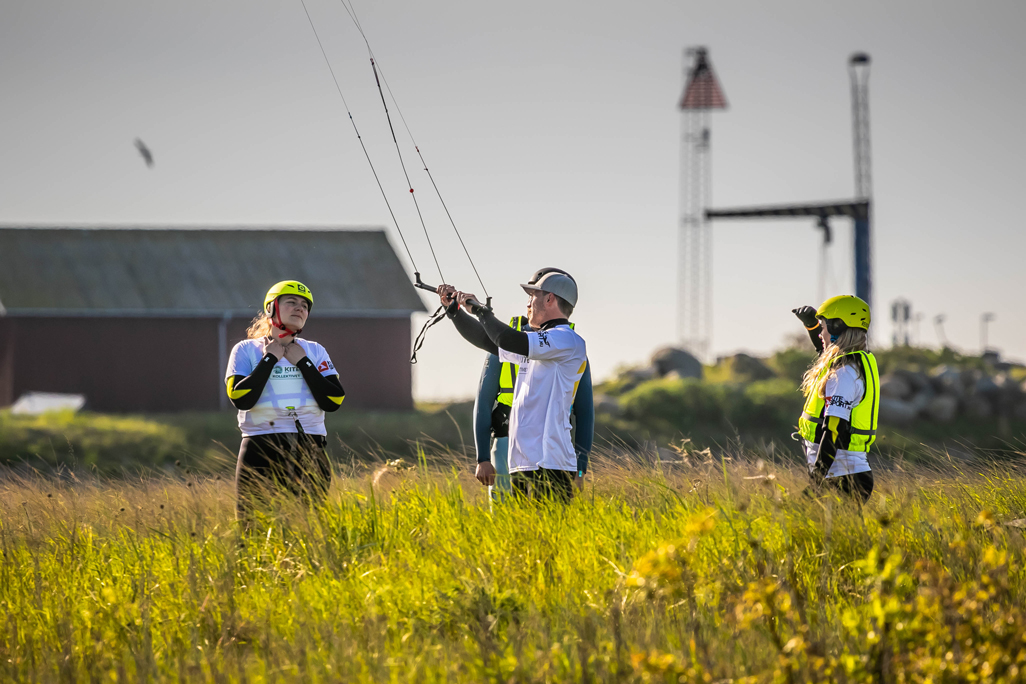Welcome to Kitekollektivet's
Kitesurfing theory
We recommend that you read through the theory to get the most out of your kitesurfing course and the sport when you start kitesurfing on your own after your lessons. Part 1 is intended for before and during your kitesurfing course, while parts 2 and 3 are intended for after your kitesurfing course. Our theory folder consists of 3 parts, which are listed below. Have a lot of fun!

PART 1 - KITESURFING THEORY
What do I need to know about kitesurfing?
Welcome to the first part of Kitekollektivet's online kitesurfing theory folder. When learning to kitesurf, theory and practice go hand in hand - some things are good to know before you take your first lessons, while other things only make sense once you've been on the water for the first time. The theory is meant to support your lessons, not replace them. We recommend that you read through the theory from the following overview to get the most out of your kitesurfing course:
- Know the theory behind TEORIBLOK I before your first 5 hours
- Hav styr på teorien bag TEORIBLOK I+II efter 8 timer og inden evt. ekstra timer
- Hav styr på teorien bag TEORIBLOK I+II+III efter minimum 11 timer
- Have a great time!

PART 1 - KITESURFING THEORY
Kitekollektivet - Theory block I
The theory behind TEORIBLOK I should be read before your lessons and before you go on the water. The theory contains essential elements for the basic skills of kitesurfing and can be revisited as needed.
Citation monology
This video introduces you to kiting terminology so you know the structure and parts of the kit before you get on the kiteboard for the first time. The video covers components and wind directions.
Security systems
This video gives you a thorough introduction to the safety systems of a modern power kite so that you are confident about kitesurfing and getting in the water for the first time. Each step is explained in detail so you'll be able to understand how safety systems work and spot situations where they don't work.
Relaunch of kiting
This video introduces you to the basic techniques used to relaunch the kite. The video covers relaunch mistakes that many kitesurfers make and shows the relaunch technique for three common situations: wing-tip relaunch, leading-edge down relaunch and trailing-edge relaunch.
Tilting
This video introduces you to all the steps of setting up a kite, which will help you before you have to do it yourself for the first time. The video also shows the downwind method, as beginners tend to make mistakes in setting up lines upwind or crosswind, where there is less time to use your quick release if something goes wrong.
The attic window
This video introduces you to the wind window, which is fundamental in kitesurfing. The wind window helps you understand how a kite works and predict how strong a kite movement will be. The better you understand the wind window, the greater the benefit and learning in your lessons.
Body dragging
This video introduces you to bodydragging. The video explains in detail everything about upwind, sidewind and crosswing bodydragging and explains how to control your direction. In addition, the video also introduces you to some of the most common mistakes to help you overcome them.
PART 1 - KITESURFING THEORY
Kitekollektivet - Theory block II
The theory behind TEORIBLOK II should be read after 5 lessons and before you get any extra lessons. The theory contains essential elements for the basic skills in kitesurfing and can be revisited as needed.
Launch theory
This video introduces you to the basic principles of kite launching - launching an inflatable kite on land. Launching is not completely risk-free, as you cannot safely launch a kite until you have gained a certain level of experience. You are usually only ready to launch when you can water-launch and ride against the wind and shift.
First time on the board
This video introduces you to how to both start and stop on the board for the first time. The video introduces you to kite control, body position, board control and typical mistakes to be aware of. It can be difficult, so you might want to watch this video again just before your first lessons.
Depower
This video introduces you to all the depower systems that are on a modern power kite. The video explains how power and depower works and then presents all the systems you can use to control depower. This includes the effect of bar position, the trim strap and the different knots that you can choose from when rigging your kite.
PART 1 - KITESURFING THEORY
Kitekollektivet - Theory block III
The theory behind TEORIBLOK III should be read after a minimum of 10 lessons. The theory contains basic knowledge on how to progress and become self-sufficient in kitesurfing.
Vigilance rules
This video introduces you to some rules of the road on the water that will help you avoid collisions with other kitesurfers. The video explains what to do if you are upwind of another kitesurfer, get close to a kitesurfer on a wave, etc.
Kit sizes and types
This video introduces you to different kite types and kite sizes to avoid you choosing the wrong size or model. The video explains the main differences between the many types of kites on the market today and how and why high aspect and low aspect kites perform differently. In addition, the video also introduces you to some options to choose from as a beginner and explains the most common terms you need to know when looking for a kite.
Weather conditions
As a kitesurfer, you need to be able to assess the weather conditions and whether it is safe to go out on the water. This video introduces you to the many factors related to wind and weather that you need to consider.
Safety pack down and self rescue
This video introduces you to how to safely, quickly and easily get your kite down and save yourself in case of an accident.